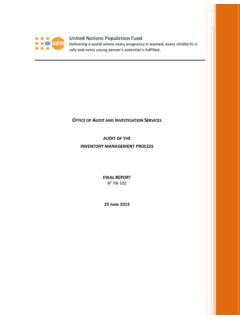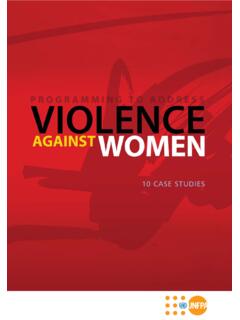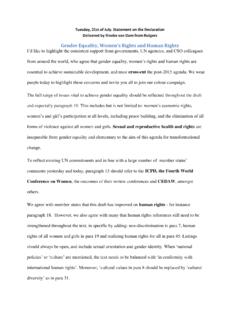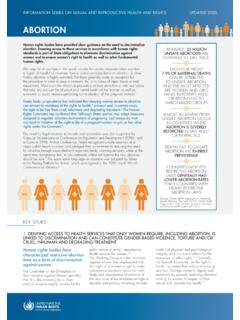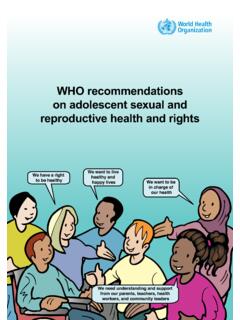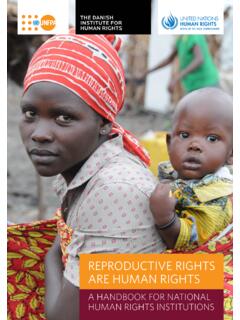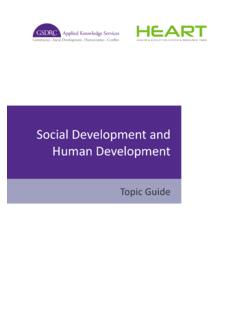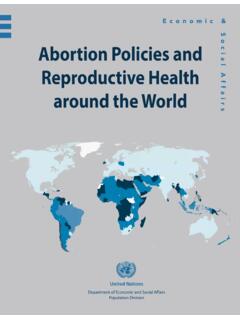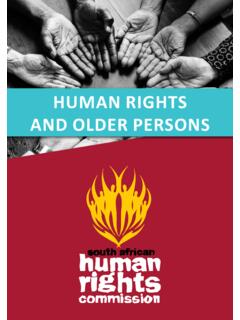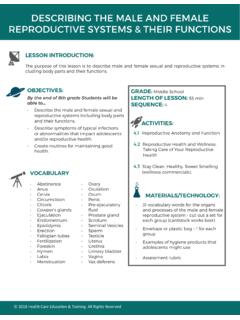Transcription of SEXUAL AND REPRODUCTIVE HEALTH - UNFPA
1 A REALITY FOR ALLMAKING REPRODUCTIVE rights ANDSEXUAL AND REPRODUCTIVE HEALTHP hoto credit cover page: Diego Goldberg/Pixel Press/UNFPAA REALITY FOR ALLMAKING REPRODUCTIVE rights ANDSEXUAL AND REPRODUCTIVE HEALTHREPRODUCTIVE rights AND SEXUAL AND REPRODUCTIVE HEALTH FRAMEwORKU nited Nations Population Fund (May 2008)2 MAKING REPRODUCTIVE rights AND SEXUAL AND REPRODUCTIVE HEALTH A REALITY FOR ALLEXECUTIVE SUMMARY ..4 INTRODUCTION ..4 PART 1: ..6A Rationale for Implementing the Strategic Plan in REPRODUCTIVE rights and SEXUAL and REPRODUCTIVE HEALTH A. DEFINITION OF REPRODUCTIVE rights AND SEXUAL AND REPRODUCTIVE HEALTH ..6B. PROGRESS SINCE CAIRO.
2 7C. SEXUAL AND REPRODUCTIVE HEALTH IN THE NEw MILLENNIUM ..7 Challenges and trendsD. THE UNFPA PROGRAMME ..81. The new environment ..82. Priority thematic areas ..113. Priority issues for UNFPA in policy dialogues, analyses and advocacy in the HEALTH sector ..124. Principles ..15 PART 2: ..16 REPRODUCTIVE rights and SEXUAL and REPRODUCTIVE HEALTH in the UNFPA Strategic Plan 2008-2011 A. OVERALL GOAL ..16B. COORDINATION wITH POPULATION AND DEVELOPMENT AND GENDER FRAMEwORKS 31D. MONITORING, EVALUATION AND ORGANIzATIONAL ARRANGEMENTS TO IMPLEMENT THE FRAMEwORK ..331. Results-based management ..332. Development of staff capacity ..343. Partnerships and United Nations coordination.
3 344. Organizational structure ..35 END NOTES ..36 CONTENTS3 MAKING REPRODUCTIVE rights AND SEXUAL AND REPRODUCTIVE HEALTH A REALITY FOR ALLAIDS Acquired immunodeficiency syndromeASRH Adolescent SEXUAL and REPRODUCTIVE healthBSCC Behavior and Social Change CommunicationCEDAW Convention on the Elimination of All Forms of Discrimination against WomenHIV human immunodeficiency virusHPV human papilloma virusICPD International Conference on Population and DevelopmentMDG Millennium Development GoalNGO Non-governmental organizationPHC Primary HEALTH carePLWHA People living with HIV/AIDSPRS Poverty-reduction strategyRDTs Regional Director TeamsRHCS REPRODUCTIVE HEALTH commodity security SDP
4 Service delivery pointSTI Sexually transmitted infectionSWAp Sector-wide approachUNAIDS Joint United Nations Programme on HIV/AIDSUNCT United Nations country teamUNDAF United Nations development assistance frameworkUNDG United Nations Development GroupUNFPA United Nations Population FundUNGASS United Nations General Assembly Special SessionUNICEF United Nations Children s FundVCCT Voluntary and confidential counselling and testing (for HIV)WHO World HEALTH OrganizationLIST OF ABBREVIATIONS AND ACRONYMS4 MAKING REPRODUCTIVE rights AND SEXUAL AND REPRODUCTIVE HEALTH A REALITY FOR ALLE xecutive summary 1. The REPRODUCTIVE rights and SEXUAL and REPRODUCTIVE HEALTH (SRH) framework has been developed to provide overall guidance and a cohesive- Fund-wide response for implementing the REPRODUCTIVE HEALTH and rights elements of the UNFPA Strategic plan 2008-2011.
5 The framework builds on the goals of the International Conference on Population and Development (ICPD), 1994; the Millennium Summit, 2000, with its adoption of the Millennium Development Goals (MDGs); the 2005 World Summit; and the addition, in 2007, of the goal of universal access to REPRODUCTIVE HEALTH to MDG 5, for improving maternal HEALTH . This includes two parts: the first provides a snapshot of the progress achieved since ICPD, identifies major remaining gaps and priorities and outlines principles and approaches for programme planning and implementation. The second part identifies key priorities and specific strategies for each of the SRH-related strategic plan Despite considerable progress since the ICPD, millions of people -- mostly disadvantaged women and adolescents -- still lack access to SRH information and services.
6 In developing countries, about 201 million married women lack access to modern contraceptives. There are about 340 million new cases of sexually transmitted infections (STIs) each year, and 6,000 young people are infected with HIV every day. Millions of women and adolescent girls continue to suffer from death and disabilities during pregnancy and childbirth. 3. UNFPA will invest in four priority areas: (a) support for the provision of a basic package of SRH services including family planning; pregnancy-related services, including skilled attendance at delivery and emergency obstetric care; HIV prevention and diagnosis and treatment of STIs; prevention and early diagnosis of breast and cervical cancers; adolescent SEXUAL and REPRODUCTIVE HEALTH (ASRH); and care for survivors of gender-based violence, with REPRODUCTIVE HEALTH commodity security (RHCS) for each component of the package emphasizing the key outcomes under the REPRODUCTIVE HEALTH and rights Goal in the Strategic Plan 2008-2011.
7 (b) the integration of HIV prevention, management and care in SRH services; (c) gender sensitive life-skills based SRH education for adolescents and youth; and (d) SRH services in emergencies and humanitarian The first task of UNFPA and its partners will be to ensure that REPRODUCTIVE rights and SRH are given increased priority in policies, planning and budget allocations in the HEALTH and other relevant sectors. UNFPA will strengthen its participation in programme-based approaches and sector-wide approaches (SWAps). The placement of SRH at the centre of policies must be reflected in budgets. This requires new technical skills to strengthen the capacity of UNFPA A key lesson learned from the Multi-Year Funding Framework (MYFF) (2004-2007) is the need to sharpen goals and define the Fund s unique niche, especially in the context of strengthened partnerships with other United Nations organizations.
8 As a result, the strategic plan contains specific outcomes for UNFPA support. The plan reflects the principles of national ownership and leadership of programming, strengthened policymaking, capacity development, continued advocacy, knowledge-sharing and South-South cooperation all of which are essential if the ICPD goals and the MDGs are to be met. UNFPA is best positioned to rally partners to support governments to take leadership on the promise of improved REPRODUCTIVE HEALTH as stated in MDG 4, 5 and 6 particularly with the addition of the new target on universal access to REPRODUCTIVE HEALTH . Introduction 6. The REPRODUCTIVE rights and SEXUAL and REPRODUCTIVE HEALTH framework has been developed to provide overall guidance for implementing the UNFPA strategic plan 2008-2011.
9 The framework presents the conceptual and operational basis for UNFPA to contribute to achieving the goals of the Programme of Action of the ICPD and the MDGs over a four year period. UNFPA is committed to accelerating action to achieve universal access to REPRODUCTIVE HEALTH within a rights -based, comprehensive and multisectoral The framework was developed to provide a cohesive Fund-wide response to address REPRODUCTIVE rights and SRH by promoting, inter alia, synergies between the Fund s thematic areas and linking REPRODUCTIVE rights and SRH relating to both physical and mental HEALTH , with population and development, gender, and adolescents and youth.
10 Given the new aid 5 MAKING REPRODUCTIVE rights AND SEXUAL AND REPRODUCTIVE HEALTH A REALITY FOR ALLenvironment and lessons from the previous MYFF, it offers a rationale for the approach in the Strategic Plan 2008-2011 to engage in policy dialogue, policy analysis and advocacy for the inclusion of SRH issues in national development strategies, plans, budgets and government-driven processes. Examples of this are Sector Wide Approaches, HEALTH -sector reform, poverty-reduction strategies (PRSs) and the MDGs, with a stronger emphasis on implementation of these plans. It explains the Strategic Plan s focus on the socially excluded and marginalized in relation to equity aspects of SRH within the HEALTH system and gender-equality concerns.
